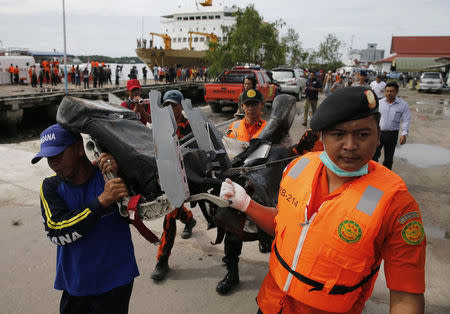AirAsia captain left seat before jet lost control: sources
By Siva Govindasamy, Kanupriya Kapoor and Tim Hepher SINGAPORE/JAKARTA/PARIS (Reuters) - The captain of the AirAsia jet that crashed into the sea in December was out of his seat conducting an unusual procedure when his co-pilot apparently lost control, and by the time he returned it was too late to save the plane, two people familiar with the investigation said. Details emerging of the final moments of Flight QZ8501 are likely to focus attention partly on maintenance, procedures and training, though Indonesian officials have not ruled out any cause and stress it is too early to draw firm conclusions. The Airbus A320 jet plunged into the Java Sea while en route from Surabaya, Indonesia, to Singapore on Dec. 28, killing all 162 people on board. People familiar with the matter said earlier this week that investigators were examining maintenance records of one of the automated systems, the Flight Augmentation Computer (FAC), and the way the pilots reacted to any outage. One person familiar with the matter said the captain had flown on the same plane with the intermittently faulty device days earlier. There was no independent confirmation of this. After trying to reset this device, pilots pulled a circuit-breaker to cut its power, Bloomberg News reported on Friday. People familiar with the matter said it was the Indonesian captain Iriyanto who took this step, rather than his less experienced French co-pilot Remy Plesel, who was flying the plane. AirAsia said it would not comment while the matter was under investigation by the National Transportation Safety Committee (NTSC) of Indonesia. The NTSC has said it is too early to say what role either human factors or equipment may have played in the crash, which is still being investigated. Experts say the loss of the FAC would not directly alter the trajectory of the aircraft but would remove flight envelope protection, which prevents a pilot from taking a plane beyond its safety limits, and require the crew to fly it manually. The decision to cut off the FAC has surprised people following the investigation because the usual procedure for resetting it is to press a button on the overhead panel. "You can reset the FAC, but to cut all power to it is very unusual," said one A320 pilot, who declined to be identified. "You don't pull the circuit breaker unless it was an absolute emergency. I don't know if there was one in this case, but it is very unusual." It is also significant because to pull the circuit breaker the captain had to rise from his seat. "STARTLED" The circuit breakers are on a wall panel immediately behind the co-pilot and hard or impossible to reach from the seated position on the left side, where the captain sits, according to two experienced pilots and published diagrams of the cockpit. Shortly afterwards the plane went into a sharp climb from which investigators have said it stalled or lost lift. "It appears he (the co-pilot) was surprised or startled by this," said a person familiar with the investigation, referring to the decision to cut power to the affected computer. The captain eventually resumed the controls, but a person familiar with the matter said he was not in a position to intervene immediately to recover the aircraft from its upset. "The co-pilot pulled the plane up, and by the time the captain regained the controls it was too late," one of the people familiar with the investigation said. Tatang Kurniadi, chief of Indonesia's NTSC, told Reuters there had been no delay in the captain resuming the controls but declined further comment. The head of the investigation, Mardjono Siswosuwarno, told reporters this week it was too early to say whether the accident involved pilot error or a mechanical fault. Indonesia has issued some of the factual circumstances, but not released its preliminary accident report. The NTSC said on Thursday the jet was in sound condition and all crew members were properly certified. Airbus declined to comment. Lawyers for the family of the French co-pilot say they have filed a lawsuit against AirAsia in Paris for “endangering the lives of others” by flying the route without official authorization on that day. Investigators have said the accident was not related to the permit issue. AirAsia did not immediately respond to requests for comment on the lawsuit. Air accidents typically give rise to conflicting liability claims, and the 2009 crash of an Air France jet is still working its way through the French judicial system. Although more is becoming known about the chain of events, people familiar with the investigation warned against making assumptions on the accident's cause, which needed more analysis. Safety experts say air crashes are most often caused by a chain of events, each of which is necessary but not sufficient to explain the underlying causes of the accident. (Editing by Will Waterman)



